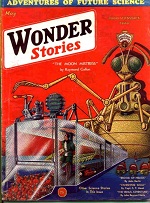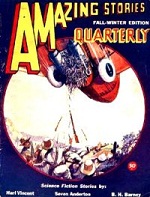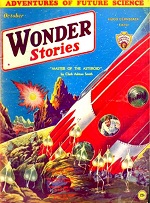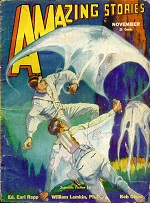|  
 
 | | | |  | | “When the Earth Tilted”
by J.M. Walsh
First publication: Wonder Stories, May 1932

After a passing comet throws the earth’s axis out of kilter, the survivors, searching for a habitable spot to live on the planet’s surface, stumble upon a colony from the lost continent of Mu, whereupon war breaks out (after all, there’s limited land available now) and the Muians have a time-travel trick up their sleeves. | |
| | | | |

 
 
 
 
 | | | |  | | “Beyond the Veil of Time”
by B.H. Barney
First publication: Amazing Stories Quarterly, Fall/Winter 1932

Mathematician Richard Nelson, Andean Indian Huayan, and engineer Dan Bradford who try to capture images from a pre-Incan city in the Andes, but instead are blown back in time and have a series of high adventures.

The story—Barney’s only publication—was a plagiaristic hodgepodge of elements from the work of A. Merritt, although Everett Bleiler’s review notes that there were imaginative and ingenious original elements. A. MERRITT, WHO IS WELL KNOWN TO MANY OF THE READERS OF AMAZING STORIES, HAS CALLED OUR ATTENTION TO MANY SIMILARITIES IN DESCRIPTIONS, CHARACTERIZATIONS AND SITUATIONS IN THE STORY "BEYOND THE VEIL OF TIME" BY B.H. BARNEY, PUBLISHED IN THE FALL-WINTER ISSUE OF AMAZING STORIES QUARTERLY, AND DESCRIPTIONS, CHARACTERIZATIONS AND SITUATIONS IN HIS TWO BOOKS "THE MOON POOL" AND "THE FACE IN THE ABYSS". MR. MERRITT OBJECTS PARTICULARLY TO THE UTILIZATION OF THE CONCEPTION AND THE NAME OF "THE DREAM-MAKERS", WHICH FORMED AN ESSENTIAL PART OF HIS "FACE IN THE ABYSS". A. MERRITT, WHO IS WELL KNOWN TO MANY OF THE READERS OF AMAZING STORIES, HAS CALLED OUR ATTENTION TO MANY SIMILARITIES IN DESCRIPTIONS, CHARACTERIZATIONS AND SITUATIONS IN THE STORY "BEYOND THE VEIL OF TIME" BY B.H. BARNEY, PUBLISHED IN THE FALL-WINTER ISSUE OF AMAZING STORIES QUARTERLY, AND DESCRIPTIONS, CHARACTERIZATIONS AND SITUATIONS IN HIS TWO BOOKS "THE MOON POOL" AND "THE FACE IN THE ABYSS". MR. MERRITT OBJECTS PARTICULARLY TO THE UTILIZATION OF THE CONCEPTION AND THE NAME OF "THE DREAM-MAKERS", WHICH FORMED AN ESSENTIAL PART OF HIS "FACE IN THE ABYSS". 

—an announcement in the June 1933 Amazing Stories
| |
| | | | |

 | | | |  | | “Chicago, 2042 A.D.”
by Paul Bolton
First publication: Wonder Stories, Oct 1932

The U.S. in the 1950s is ruled by the Jerry Ratoni of the Chicago mob, which Wakefield plans to infiltrate, but things go wrong when Ratoni, Wakefield and Ratoni’s secretary are transported to 2042, where the mob still rules. | |
| | | | |

 | | | |  | | “The Man Who Lived Twice”
by William Kober
First publication: Amazing, Nov 1932

In a dire time of war, a man from the Bureau of Standards in look of new weapons visits Professor Dane who claims he can travel to the future, which our man from the Bureau does, but he finds an alien invasion instead of great new weapons. | |
| | | | |

 
No Time Travel. Move along. |
The Gap in the Curtain by John Buchan [visions of possible futures ]

“The Einstein See-Saw” by Miles J. Breuer, Astounding, Apr 1932 [monster-filled universes ]

“The Finger of the Past” by Miles J. Breuer, Amazing, Nov 1932 [viewing the past ]

| |     |